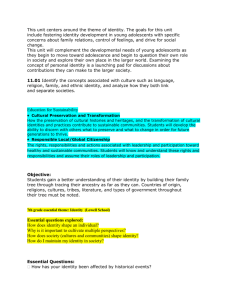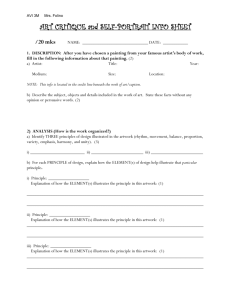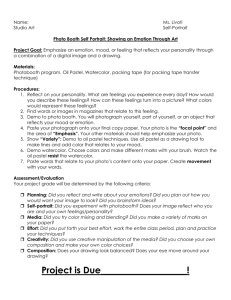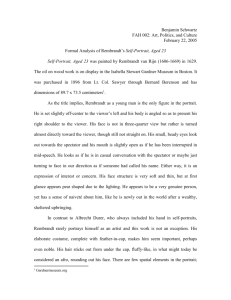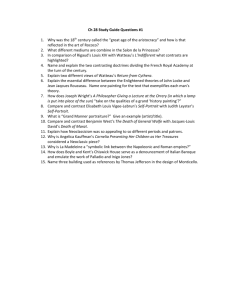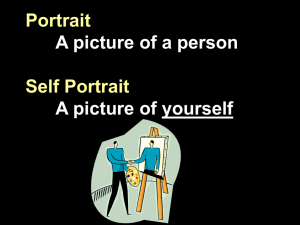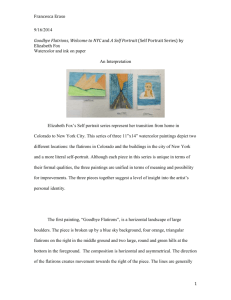SELF-PORTRAITS FROM C17th TO C21st
advertisement
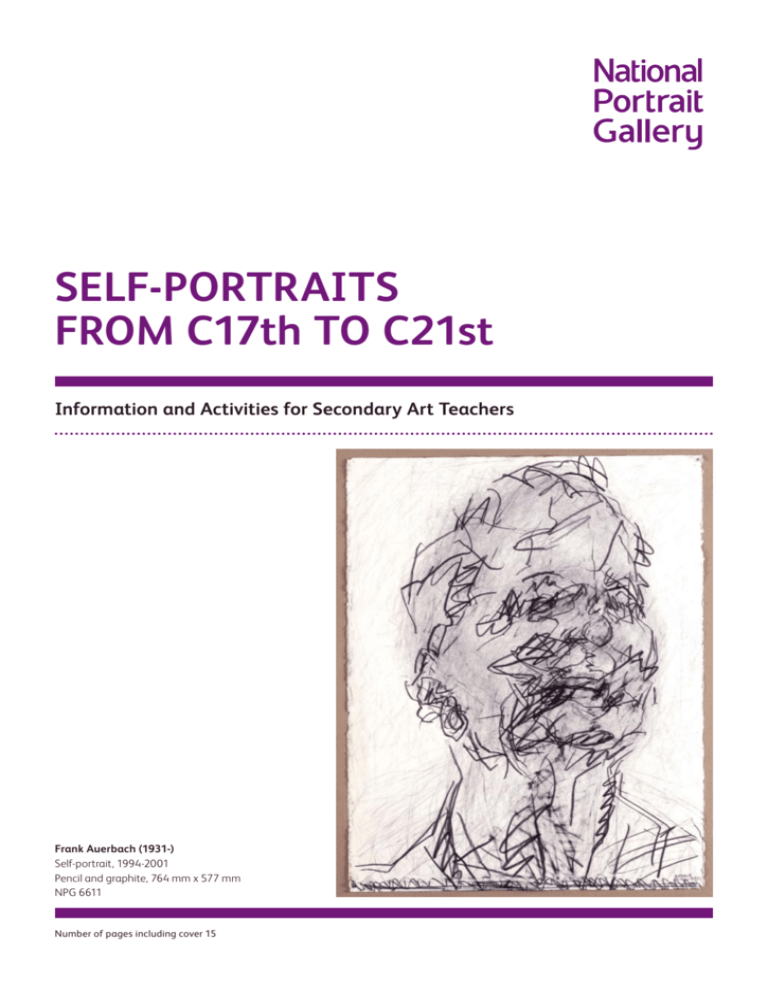
SELF-PORTRAITS FROM C17th TO C21st Information and Activities for Secondary Art Teachers Frank Auerbach (1931-) Self-portrait, 1994-2001 Pencil and graphite, 764 mm x 577 mm NPG 6611 Number of pages including cover 15 2 /15 Information and Activities for Secondary Art Teachers Self-portraits from the C17th to C21st Self-advertisement The self-portrait is the artist’s most intimate personal legacy, and most public form of self-advertisement. Self-portraits are often specific in intention, recording particular moments in an artist’s personal or professional life. We find certain works clearly state the artist’s occupation by the inclusion of brushes, palettes, portfolios, pencils, easels; whilst others indicate success and status by concentrating on fashionable clothing, smart interiors and diverse proofs of wealth. The very nature of the drawing or painting, the actual technique of applying ink, pencil, chalk or charcoal to paper, or paint to canvas - the distinguishable mark-making - can convey information about the character and type of artist represented. Artists define their aesthetic perceptions by every decision made in the art-work produced. Each line, colour, shape and the consequent relationships between them become part of the expressive self and define a creative identity. ‘I am my style’, said Paul Klee. Self-image In a self-portrait the artist is his or her own flexible and free model; always available, day or night, ready to take on any number of disguises, gestures or expressions, without needing to explain these to a sitter, or to analyse the reasons for themselves. Self-portraits are rarely commissioned works, and thus they have their own autonomy and sense of self-investigation, unrestricted by outside constraints. Self-knowledge The self-portrait records physical appearance, and some artists examine how they age by repeatedly recording themselves. Sometimes mood, feelings, character and emotions invade the picture and these works have an independent spirit of their own. Because this type of work combines shrewdly-observed physical characteristics with artistic bravura, a naked quality of self-knowledge emerges. Teachers’ Notes Self-portraits from C17th to C21st National Portrait Gallery 3 /15 Information and Activities for Secondary Art Teachers Self-portraits from the C17th to C21st Sir Peter Lely (1618-80) Self-portrait, c. 1660 Oil on canvas, 1,080 x 876 mm NPG 3897 Lely’s head and hands glow dimly like mysterious light bulbs within this sombre canvas. His somewhat supercilious look suggests a haughty confidence and this impression is reinforced by the contraposto position and bravura painting of the white cuff. His left hand grasps a female statuette; symbolic of the aesthetic world and his power over it (and women?). Naturally flowing locks frame a handsome face. This rather arrogant yet beautiful portrait has an almost stately quality. It proclaims ‘here is the King’s painter, Van Dyck’s proud heir.’ He was in London by 1647 and (by this date he had painted Charles I). He became Principal Painter to Charles II in 1661, and maintained a large studio (on Van Dyck lines) where portraits of an International Baroque Style were produced at a tremendous rate. He is known for the series of beauties at Hampton Court, and the splendid Admirals at the Maritime Museum, Greenwich. Works entirely painted by him (such as this self-portrait) attain a level of beauty akin to Van Dyck. Others, where he has only been responsible for certain elements (head and hands) reveal the problems inherent in the studio system. Lely was born in Germany of Dutch parents, studied in Haarlem, becoming a member of the Haarlem Guild in 1637. Teachers’ Notes Self-portraits from C17th to C21st National Portrait Gallery 4 /15 Information and Activities for Secondary Art Teachers Self-portraits from the C17th to C21st Mary Beale (1633-99) Self-portrait, c. 1665 Oil on canvas, 1,092 x 876 mm NPG 1687 Mary Beale was one of the very few women artists working in England in the seventeenth century. She presents herself here as artist and mother. Behind her on the wall her trade is symbolised by her palette, only barely distinguishable in the background gloom. In her right hand she holds an unfinished painting of her two sons, Bartholomew and Charles; we can see clearly the nails which secure the edges of the canvas onto the small stretcher. Beale is dressed in the flowing fashion of the day, and although the rendering of the drapes is somewhat awkward, her handling of the faces is solid and convincing. Teachers’ Notes Self-portraits from C17th to C21st Born Mary Cradock in Suffolk, she was the daughter of a clergyman. Little is known of her artistic training. She was married in 1652 to Charles Beale, an artist’s colourman who prepared her pigments and canvases, and also made brushes and other items required by artists). They moved to London c.1655 and were befriended by Sir Peter Lely. It is said that Lely passed on to her the portrait work that he didn’t want. The stylistic influence of Lely on Beale is clearly visible, on his death in 1680, fashions in portraiture began to change and Mary’s style became outmoded. National Portrait Gallery 5 /15 Information and Activities for Secondary Art Teachers Self-portraits from the C17th to C21st Sir Godfrey Kneller Bt. (1646-1723) Self-portrait, c. 1706-11 Oil on canvas, 464 x 356 mm NPG 3214 This is a typical baroque portrait. It is related to the famous group of portraits painted by Kneller depicting Whig supporters who met regularly at Christopher Cat’s Tavern and ate meat pies known as ‘Kit-cats’, but it is smaller than the rest (all the others measure 36 x 28 inches, the original pre-fabricated ‘Kit-cat’ canvas measurements). This image was engraved at the same time as the others in 1735 and so became part of the group. Kneller is richly dressed with a full wig, a sword, which was probably presented to him by King William in 1692, and a gold chain, also given by the King in 1699. The medal bears the King’s head and was valued at £300. In the background we see Kneller’s house, Whitton Hall, Twickenham, built in 1709-11. Teachers’ Notes Self-portraits from C17th to C21st Born in Lübeck, Kneller trained in Amsterdam under Rembrandt’s pupil Ferdinand Bol. He arrived in England in 1674 after visiting Italy. He became Principal Painter to the King in 1691 and was made a Baronet in 1715, the first painter in England to be so honoured. He was a prolific, often mechanical painter, who reworked Lely’s style and poses. His best works were painted ‘alla prima’; painting all of the surface of the canvas in one sitting and in one ‘layer’. This method requires a great deal of skill and confidence and produces lively and vigorous work. Kneller employed numerous assistants to help him and this accounts for the variable quality of the work he produced. He was known to be a conceited man and perhaps this shows in his self-portrait. National Portrait Gallery 6 /15 Information and Activities for Secondary Art Teachers Self-portraits from the C17th to C21st William Hogarth (1697-1764) Self-portrait, c. 1757 Oil on canvas, 451 x 425 mm NPG 289 This self-portrait was painted the year Hogarth achieved his life-long ambition becoming Sergeant Painter to the King (on 16 June 1757) and shows Hogarth in typically didactic mood. We see him seated and ready to start painting his figure of the Comic Muse, whose form, mask in hand, is outlined in white on a grey ground. His palette is held at an angle so that we can view the order in which he lays out his colours sequentially; from dark to light. He grasps five brushes in his left hand (a different brush for each different colour, to avoid ‘muddying colours’), and in his right a palette knife which he uses to mix the tints, tones and colours on the palette. Hogarth was born in London, and originally trained as a silversmith. He then worked as an engraver prior to taking up painting in the late 1720s. He executed a series of ‘modern Teachers’ Notes Self-portraits from C17th to C21st moral subjects’, firstly in paint and subsequently engraved for wider public distribution and sale. Subjects included; ‘The Harlot’s Progress’, ‘The Rake’s Progress’ and ‘Marriage à la Mode’. His works were popular and they were often pirated. This led him to lobbying for the passing of the Copyright Act, made law in 1735, which protected artists’ work from unlawful reproduction. Fiercely patriotic, he championed British art against the French and Italian masters. He set up the first public exhibition space in the country at the Foundling Hospital and encouraged student painters at the St Martin’s Lane Academy. The X-ray of this work shows original underpainting of his dog, Trump, cocking his leg and relieving himself over Old Master drawings. National Portrait Gallery 7 /15 Information and Activities for Secondary Art Teachers Self-portraits from the C17th to C21st Sir Joshua Reynolds (1723-92) Self-portrait, c. 1747 Oil on canvas, 630 x 740 mm NPG 41 This self-portrait was reduced in size in the early nineteenth century; it is estimated that approximately 17 cm were cut off the top and 7 cm off the bottom of the painting. The resulting oblong is a very unusual shape for a halflength portrait and the crowded composition is untypical of Reynolds, who preferred to leave more space around his subject. Always a stylish dresser, we see him here in a fashionable, informal frock coat, a blue silk waistcoat worn à la mode open to mid-chest and his own loosely curled hair rather than a formal wig. He holds a mahl stick and a shovel palette; behind him stands a canvas, at the ready. Teachers’ Notes Self-portraits from C17th to C21st Reynolds was born in Devon to an educated family; his father was headmaster of Plympton Grammar School. Later in life he became close friends with Dr Johnson, Goldsmith, Garrick and Burke. He left England to visit Italy in 1749 where he was able to study antique and Renaissance works; here he discovered the ‘Grand Style’. When the Royal Academy was founded in 1768, he became President and subsequently delivered fifteen ‘Discourses’ (lectures). Together with Gainsborough and Hogarth, he is regarded as one of the most famous British artists of the eighteenth century. He is also renowned for his poor technical procedures; few of his works survive in good condition. National Portrait Gallery 8 /15 Information and Activities for Secondary Art Teachers Self-portraits from the C17th to C21st Angelica Kauffmann (1741-1807) Self-portrait, c. 1770-75 Oil on canvas, 737 x 610 mm NPG 430 In this self-portrait Angelica Kauffmann points to herself whilst looking at us. She balances her drawing book under her right hand which is poised ready to make a mark with her pastel. The pastel is held firmly in a ‘porte-crayon’ - a pastel holder which gave the artist using pastels flexibility of movement and made gestured marks easier to execute through added length. At this time pastels would have been quite stumpy and frail as they were hand-made from pure pigment and gum arabic. The painting is bathed in a warm, soft light. Her skin appears translucent and her clothing softly echoes the folds and curls of her tumbling hair. Distinctly feminine and seductive, the painting also reinforces the Teachers’ Notes Self-portraits from C17th to C21st determination and skill of the woman artist, in the way that she presents herself with the tools of her trade. Born in Switzerland, Kauffmann chose to be a visual artist rather than a musician. She went to Rome in 1763, where she met and painted Winckelmann in 1764; this portrait helped to make her name. Between 1766-81 she was in London, in 1768, she became friends (some say intimate) with Joshua Reynolds who, like her, was a founder member of the Royal Academy . Her decorative history pieces were widely engraved and used in the manufacture of objets d’art. National Portrait Gallery 9 /15 Information and Activities for Secondary Art Teachers Self-portraits from the C17th to C21st George Romney (1734-1802) Self-portrait, 1782 Oil on canvas, 1,257 x 991 mm NPG 959 The problem and the delight of this portrait lie in its unfinished state. Romney’s crossed arms are unconvincing, their flatness deny the magic of the fully worked face and our eyes tend to ‘hop’ from this aspect of the self-portrait to the other. Why, if the face is so convincingly portrayed, did he not try to complete the rest of the painting to the same high standard? The portrait’s unfinished state does however, give us an insight into the artist’s method; a rough outline forms the basis of this simple, self-contained, and somewhat confrontational portrait. Yet it is his expression, the serious, calculating way in which he fixes his eye on us, which commands our attention. Teachers’ Notes Self-portraits from C17th to C21st This, combined with the low-key, sombre palette and the brief indication of light glancing off his forehead, provide us with a deeply felt study of Romney’s physical and psychological state. Romney was born in Lancashire and worked in the North until 1762 when he moved to London. In 1773 he left London, where Reynolds was at the height of his power, and moved to Italy. (Gainsborough moved to London in 1774.) He was famous for painting numerous portraits of Emma Hamilton, often transforming her into historical or mythological characters. National Portrait Gallery 10 /15 Information and Activities for Secondary Art Teachers Self-portraits from the C17th to C21st Dante Gabriel Rossetti (1828-82) Self-portrait, 1847 Pencil and pastel on paper, 197 x 178 mm NPG 857 Fey and romantic, Rossetti’s self-portrait is a brief likeness of a youthful Pre-Raphaelite. The brown tinted paper provides a warm mid-tone. The blacks are used to delineate features, free-falling shoulder length hair and elegant, foppish bow-tie, whilst the bright highlights made in chalk lift the forehead, make the nose more three-dimensional and giving the shirt ‘body’. The drawing has all the delicacy of a nineteen-year-old artist’s candid self-view. Teachers’ Notes Self-portraits from C17th to C21st Rossetti was the son of an Italian political refugee in London. He trained with Cotman, Ford Madox Brown and Holman Hunt, and was a founder-member of the Pre-Raphaelite Brotherhood. He met Elizabeth Siddal in 1852, they married in 1860, and two years later she died from an overdose of laudanum. He produced his best work during the time they knew each other and went into decline after her death. Many of his subjects were drawn from Dante and the medieval period, and he also wrote verse inspired by these themes. National Portrait Gallery 11 /15 Information and Activities for Secondary Art Teachers Self-portraits from the C17th to C21st Isaac Rosenberg (1890-1918) Self-portrait, 1915 Oil on panel, 295 x 222 mm NPG 4129 Isaac Rosenberg was born in Bristol, but aged seven, his family moved to Stepney, London. Like Mark Gertler, whom he met at the Whitechapel Library, he won a Jewish scholarship to the Slade where he studied between 1911-13. His fellow students included David Bomberg and Stanley Spencer. Ezra Pound encouraged him to write poetry and he published two anthologies ‘Night and Day’ (1912), and ‘Youth’ (1915). He joined the army in 1915, serving on the Western Front where he was killed in action near Arras in April 1918. Two well-known poems stem from this period; ‘Break of Day in the Trenches’ and ‘Louse Hunting’. Teachers’ Notes Self-portraits from C17th to C21st This evocative self-portrait is a frank rendering of the artist, his piercing blue eyes stare out at us from the shadows created by his hat. The cynical, somewhat imperious look, is at odds with the warmth of the colours that he uses in this small painting. He fills out the picture space, his head hemmed in by the tight scale. The pattern of the brushstrokes are broad and consistently vertical, shuddering almost shimmering over the surface of the wooden panel. National Portrait Gallery 12 /15 Information and Activities for Secondary Art Teachers Self-portraits from the C17th to C21st Anna Katrina Zinkeisen (Mrs Heseltine) Self-portrait, circa 1944 Oil on canvas, 752 mm x 625 mm NPG 5884 Anna Zinkeisen was a portrait painter and muralist. She won a scholarship to the Royal Academy Schools from Harrow School of Art, and in 1920 and 1921 she won the Landseer Award. She later worked for Wedgwood as a ceramics designer. She and her big sister Doris, were known as ‘Big’ and ‘Little Zinc’, and together they contributed murals to the passenger liners the Queen Mary and the Queen Elizabeth. Anna later specialised in pathological and clinical Teachers’ Notes Self-portraits from C17th to C21st drawing and during the Second World War she worked in the mornings in the casualty ward at St Mary’s Hospital, Paddington, and in the afternoons painted in a disused operating theatre. This vibrant life size work shows her in painting attire, save for a bracelet bearing the insignia of the St John’s Ambulance Brigade; an enamelled Maltese Cross, the Order of St. John of Jerusalem. National Portrait Gallery 13 /15 Information and Activities for Secondary Art Teachers Self-portraits from the C17th to C21st Graham Sutherland (1903-80) Self-portrait, 1977 Oil on canvas, 527 x 502 mm NPG 5338 Graham Sutherland’s self-portrait has that freshness of colour which we associate with his early abstract landscape work. Here the green surrounds him as symbolic backdrop rather than as real landscape. With a canny look, he appears almost to be chuckling at us as we peek at him looking out at us over his sketch pad. He is in the act of drawing himself; his pad resting on his knees propped against the edge of the mirror. The paintwork is patchy and there is a strong graphic quality to the rendering of the face; wrinkles are clearly marked in black and this part of the painting is the most finished. The area taken up by the sitter is balanced almost equally by the green space. Sutherland places Teachers’ Notes Self-portraits from C17th to C21st himself hunched in the right hand corner and this, together with his hands clasping the white pad, give the painting its claustrophobic effect. Born in London, he specialised in etching at Goldsmiths School of Art (1921-6) but turned to landscape painting in the 1930s after visiting Pembrokeshire. In 1949 he painted Somerset Maugham (Tate Collection) and this work established his portrait painting reputation. This self-portrait was painted for an exhibition of Sutherland’s work held at the National Portrait Gallery in 1977, and it was presented by his widow to the Gallery in 1980. National Portrait Gallery 14 /15 Information and Activities for Secondary Art Teachers Self-portraits from the C17th to C21st Frank Auerbach (1931-) Self-portrait, 1994-2001 Pencil and graphite, 764 mm x 577 mm NPG 6611 Born in Berlin, Auerbach came to England in 1939, a refugee from Nazi oppression which claimed both his parents. While still a student at St Martin’s School of Art in the early 1950s, Auerbach attended night classes given by David Bomberg at Borough Polytechnic. Bomberg taught Auerbach his passion for ‘form’ and Auerbach remarked that ‘It was those standards and his impatience with anything less that I found stimulating’. Auerbach is known for this same passion and for the amount of time he spends reworking the subjects of his Teachers’ Notes Self-portraits from C17th to C21st art, this is revealed in the dating of this drawing; seven years in the making. Self-portraits are a rare aspect of his work; this drawing is only one of five in existence. He is more interested in repeatedly depicting his small circle of regular sitters rather than himself, some of whom he has been painting for twenty years and he acknowledges the difficulty in self-portraiture, the “chasing one’s own shadow’’. Drawing is an essential part of his daily activity and at the heart of his artistic practice. National Portrait Gallery 15 /15 Information and Activities for Secondary Art Teachers Self-portraits from the C17th to C21st Activity Questions The following types of questions can be asked while viewing the images to stimulate discussion about the images. As you consider each work, it is important to remember that you are looking at a digital reproduction of an original artwork. The scale will generally be different and neither texture nor colour will be totally accurate: Why do you think that artists make self-portraits? Do you think a self-portrait is easy to sell? Who would buy an artist’s self-portrait, and why? What do you think a self-portrait can show? (- What the artist looks like ? - How they feel? - What type of artwork they produce?) What does the portrait reveal about the time in which the artist lived? Some people think that the self-portrait is the most interesting kind of portrait. Why do you think this is the case and, do you disagree or agree? As you consider each work, think of these questions: What is it made of? How old is the work? How long do you think it took the artist to make? What scale is it? How much of the artist can we see? What (if anything) is in the work in addition to the portrait? Have any particular props or symbols been used in order to assist the viewer to understand the work? What type of clothing is he or she wearing? How is the figure lit? What type of colours has the artist used? Is the artist posing in any particular way? Is he or she trying to tell us anything through the pose or gesture? Do you think that an artist would make more than one self-portrait? Do you think that the self-portrait is like an advertisement for the type of work that an artist can make? Teachers’ Notes Self-portraits from C17th to C21st National Portrait Gallery
